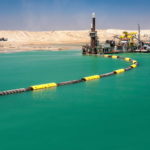After only nine months dredging time, the »new« Suez Canal is open since August. HANSA looks at the tasks for one of the sub-projects from a dredging company´s perspective
The project has created better transit circumstances. Now the distance over which vessels can cross each other is considerably longer[ds_preview] with the advantage, that waiting times can be reduced. Two joint ventures were awarded for five contract lots.
HANSA shows some details of one of the joint ventures, comprising the dredging companies Royal Boskalis Westminster and Van Oord from the Netherlands, Jan De Nul from Belgium and the National Marine Dredging Company from the United Arab Emirates (UAE).
The tendering procedure took place in August and September 2014, after Egypt’s president Abdel Fattah Al-Sisi announced the decision to creating a new canal parallel to the existing Suez Canal. In the end, four international dredging companies under the umbrella of the »Challenge Consortium« received the contract. The goal of the project was to expand the Suez Canal to allow for the transit of vessels in both directions over much of the canal’s length. This relates to around 72km. Part of this expansion was the construction of a parallel canal with 35km length, between 147m and 177m width and 24m depth. The dimensions of the parallel canal allow ships with a 66ft draft to transit freely.
The companies finished their works on 31st July already, followed by the official inauguration of the new Suez Canal by As-Sisi.
According to Jaap Dekker, Boskalis’ Project Director of the Challenge Consortium, the cooperation with the partners on the one hand and the Egyptian authorities on the other hand went very well – although there have been several huge tasks regarding the coordination of the works.
»While coordinating the dredging fleet was a gigantic operation, an even greater challenge lay in mobilizing all the auxiliary equipment and organizing the logistics and installation of everything needed to allow the dredgers to get to work. The planning for the ships was a complex puzzle. The trick was to use the right equipment in the right place, taking the various types of soil into account, and the maximum dredging depth of the smaller dredgers. This meant that work was underway in 10 areas at the same time. Also housing 2,000 people at work on the project was quite a challenge«, Dekker explains.
The financial volume of the contract was 1.5 bn $, with each of the four partners entitled to an equal share of 375mill. $. All in all, 220mill. m3 of sand, sandstone and clay had to be dredged, with record volumes of 1.4mill. m3 a day. The material was pumped to the assigned sandfill basins, which were located on both sides of the canal along its length, using in total more than 80km of pipeline.
»In terms of the scope and extremely short deadline with only 9 to 10 months execution time, this project was unique. The speed at which we managed to mobilize the largest dredging fleet ever with very limited time for preparation is unparalleled«, Dekker says.
In total the Challenge Consortium deployed a record number of 21 cutter suction dredgers, five trailing suction hopper dredgers and two water injection dredgers. In addition more then 40 pieces of auxiliary equipment have been deployed – like multicast, tugs, barges, accommodation vessels etc.
Boskalis provided the cutter suction dredgers »Phoenix I«, »Cyrus II«, »Jokra I« and »Edax« as well as the trailing suction hopper dredgers »Oranje«, »Coastway« and »Brent Zanen«.
As one of the results of all the works at Suez Canal, vessels’ waiting time for transit has been eradicated entirely for up to 50 ships per day according to the Canal Authority. The southbound transit time is reduced from 18 to eleven hours. »Moreover, the additional channel allows for double the traffic to transit per day. The canal expects to see around 97 vessels pass through per day by 2023. Prior to the project, the canal saw an average of just 49 vessels per day«, the authority says. It expects the New Suez Canal to increase its revenues from 5.3 bn $ per annum to 13.3 bn $ by 2023.
Michael Meyer





















